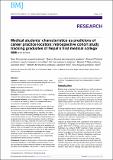| dc.contributor.author | Zimmerman, Mark | |
| dc.contributor.author | Shakya, Rabina | |
| dc.contributor.author | Pokhrel, Bharat M | |
| dc.contributor.author | Eyal, Nir | |
| dc.contributor.author | Rijal, Basista P | |
| dc.contributor.author | Shrestha, Ratindra N | |
| dc.contributor.author | Sayami, Arun | |
| dc.date.accessioned | 2013-03-27T18:51:28Z | |
| dc.date.issued | 2012 | |
| dc.identifier.citation | Zimmerman, Mark, Rabina Shakya, Bharat M Pokhrel, Nir Eyal, Basista P Rijal, Ratindra N Shrestha, and Arun Sayami. 2012. Medical students’ characteristics as predictors of career practice location: retrospective cohort study tracking graduates of nepal’s first medical college. BMJ : British Medical Journal 345:e4826. | en_US |
| dc.identifier.issn | 0959-8138 | en_US |
| dc.identifier.uri | http://nrs.harvard.edu/urn-3:HUL.InstRepos:10471508 | |
| dc.description.abstract | Objective: To determine, in one low income country (Nepal), which characteristics of medical students are associated with graduate doctors staying to practise in the country or in its rural areas. Design: Observational cohort study. Setting: Medical college registry, with internet, phone, and personal follow-up of graduates. Participants: 710 graduate doctors from the first 22 classes (1983-2004) of Nepal’s first medical college, the Institute of Medicine. Main outcome measures: Career practice location (foreign or in Nepal; in or outside of the capital city Kathmandu) compared with certain pre-graduation characteristics of medical student. Results: 710 (97.7%) of the 727 graduates were located: 193 (27.2%) were working in Nepal in districts outside the capital city Kathmandu, 261 (36.8%) were working in Kathmandu, and 256 (36.1%) were working in foreign countries. Of 256 working abroad, 188 (73%) were in the United States. Students from later graduating classes were more likely to be working in foreign countries. Those with pre-medical education as paramedics were twice as likely to be working in Nepal and 3.5 times as likely to be in rural Nepal, compared with students with a college science background. Students who were academically in the lower third of their medical school class were twice as likely to be working in rural Nepal as those from the upper third. In a regression analysis adjusting for all variables, paramedical background (odds ratio 4.4, 95% confidence interval 1.7 to 11.6) was independently associated with a doctor remaining in Nepal. Rural birthplace (odds ratio 3.8, 1.3 to 11.5) and older age at matriculation (1.1, 1.0 to 1.2) were each independently associated with a doctor working in rural Nepal. Conclusions: A cluster of medical students’ characteristics, including paramedical background, rural birthplace, and lower academic rank, was associated with a doctor remaining in Nepal and with working outside the capital city of Kathmandu. Policy makers in medical education who are committed to producing doctors for underserved areas of their country could use this evidence to revise their entrance criteria for medical school. | en_US |
| dc.language.iso | en_US | en_US |
| dc.publisher | BMJ Publishing Group Ltd. | en_US |
| dc.relation.isversionof | doi:10.1136/bmj.e4826 | en_US |
| dc.relation.hasversion | http://www.ncbi.nlm.nih.gov/pmc/articles/PMC3419272/pdf/ | en_US |
| dash.license | LAA | |
| dc.subject | Epidemiologic Studies | en_US |
| dc.subject | Undergraduate | en_US |
| dc.subject | Medical Humanities | en_US |
| dc.title | Medical students’ characteristics as predictors of career practice location: retrospective cohort study tracking graduates of Nepal’s first medical college | en_US |
| dc.type | Journal Article | en_US |
| dc.description.version | Version of Record | en_US |
| dc.relation.journal | BMJ : British Medical Journal | en_US |
| dash.depositing.author | Eyal, Nir | |
| dc.date.available | 2013-03-27T18:51:28Z | |
| dc.identifier.doi | 10.1136/bmj.e4826 | * |
| dash.contributor.affiliated | Eyal, Nir | |


